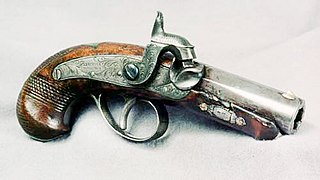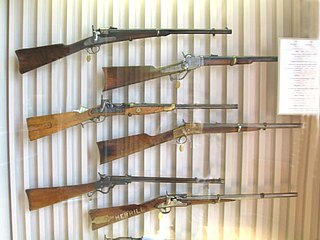
A firearm is any type of gun that uses an explosive charge and is designed to be readily carried and used by an individual. The term is legally defined further in different countries.

In firearm designs, the term single-shot refers to guns that can hold only a single round of ammunition inside and thus must be reloaded manually after every shot. Compared to multi-shot repeating firearms ("repeaters"), single-shot designs have no moving parts other than the trigger, hammer/firing pin or frizzen, and therefore do not need a sizable receiver behind the barrel to accommodate a moving action, making them far less complex and more robust than revolvers or magazine/belt-fed firearms, but also with much slower rates of fire.
A muzzleloader is any firearm in which the user loads the projectile and the propellant charge into the muzzle end of the gun. This is distinct from the modern designs of breech-loading firearms, in which user loads the ammunition into the breech end of the barrel. The term "muzzleloader" applies to both rifled and smoothbore type muzzleloaders, and may also refer to the marksman who specializes in the shooting of such firearms. The firing methods, paraphernalia and mechanism further divide both categories as do caliber.

Flintlock is a general term for any firearm that uses a flint-striking ignition mechanism, the first of which appeared in Western Europe in the early 16th century. The term may also apply to a particular form of the mechanism itself, also known as the true flintlock, that was introduced in the early 17th century, and gradually replaced earlier firearm-ignition technologies, such as the matchlock, the wheellock, and the earlier flintlock mechanisms such as the snaplock and snaphaunce.

The M1 Garand or M1 rifle is a semi-automatic rifle that was the service rifle of the U.S. Army during World War II and the Korean War.
A repeating rifle is a single-barreled rifle capable of repeated discharges between each ammunition reload. This is typically achieved by having multiple cartridges stored in a magazine and then fed individually into the chamber by a reciprocating bolt, via either a manual or automatic action mechanism, while the act of chambering the round typically also recocks the hammer/striker for the following shot. In common usage, the term "repeating rifle" most often refers specifically to manual repeating rifles, as opposed to self-loading rifles, which use the recoil, gas, or blowback of the previous shot to cycle the action and load the next round, even though all self-loading firearms are technically a subcategory of repeating firearms.
The Baker rifle was a flintlock rifle used by the rifle regiments of the British Army during the Napoleonic Wars. It was the first British-made rifle that the British armed forces issued as a standard weapon for all line companies in a regiment. The Pattern 1776 Infantry rifle had been issued on a limited basis of 10 per regiment to units serving in the American War of Independence.

Henry Deringer was an American gunsmith. He is best known for inventing and giving his name to the derringer pistol.
A rifled musket, rifle musket, or rifle-musket is a type of firearm made in the mid-19th century. Originally the term referred only to muskets that had been produced as a smoothbore weapon and later had their barrels replaced with rifled barrels. The term later included rifles that directly replaced, and were of the same design overall as, a particular model of smoothbore musket.

The M1819 Hall rifle was a single-shot breech-loading rifle designed by John Hancock Hall, patented on May 21, 1811, and adopted by the U.S. Army in 1819. It was preceded by the Harpers Ferry M1803. It used a pivoting chamber breech design and was made with either flintlock or percussion cap ignition systems. The years of production were from the 1820s to the 1840s at the Harpers Ferry Arsenal. This was the first breech-loading rifle to be adopted in large numbers by any nation's army, but not the first breech-loading military rifle – the Ferguson rifle was used briefly by the British Army in the American Revolutionary War. The Hall rifle remained overshadowed by common muskets and muzzleloading rifles which were still prevalent until the Civil War. The early flintlocks were mostly converted to percussion ignition.

The origins of the modern British military rifle are within its predecessor the Brown Bess musket. While a musket was largely inaccurate over 100 yards (91 m), due to a lack of rifling and a generous tolerance to allow for muzzle-loading, it was cheap to produce and could be loaded quickly. The use of volley or mass firing by troops meant that the rate of fire took precedence over accuracy.

A handgun is a firearm designed to be usable with only one hand. It is distinguished from a long gun which needs to be held by both hands and braced against the shoulder. Handguns have shorter effective ranges compared to long guns, and are much harder to shoot accurately. While most early handguns are single-shot pistols, the two most common types of handguns used in modern times are revolvers and semi-automatic pistols, although other handguns such as derringers and machine pistols also see infrequent usage.
The evolution of German military rifles is a history of common and diverse paths followed by the separate German states, until the mid-19th century when Prussia emerged as the dominant state within Germany and the nation was unified. This article discusses rifled shoulder arms developed in or for the military of the states that later became Germany; it excludes firearms of the Austrian Empire, except where they were used substantially by German troops.
During the American Civil War, an assortment of small arms found their way onto the battlefield. Though the muzzleloader percussion cap rifled musket was the most numerous weapon, being standard issue for the Union and Confederate armies, many other firearms, ranging from the single-shot breech-loading Sharps and Burnside rifles to the Spencer and the Henry rifles - two of the world's first repeating rifles - were issued by the hundreds of thousands, mostly by the Union. The Civil War brought many advances in firearms technology, most notably the widespread use of rifled barrels.
The Harper's Ferry M1803 rifle was the first standard rifle, made by an American armory.

The Merrill carbine was a breechloader firearm designed by Baltimore, Maryland gunsmith and inventor James H. Merrill. It was one of several firearms either manufactured or altered by Merrill in fulfillment of contracts with the Union government during the U.S. Civil War.
The M1817 common rifle was a flintlock muzzle-loaded weapon issued due to the Dept. of Ordnance's order of 1814, produced by Henry Deringer and used from the 1820s to 1840s at the American frontier. Unlike the half octagon barreled M1814 common rifle that preceded it, it had a barrel that was round for most of its length. The 36-inch barrel was rifled for .54 caliber bullets. For rifling it had seven grooves. Like the M1814 common rifle, it had a large oval patch box in the stock, however the stock dropped steeper than on the M1814 common rifle.

A multiple-barrel firearm is any type of firearm with more than one gun barrel, usually to increase the rate of fire or hit probability and to reduce barrel erosion or overheating.

The 1792 contract rifle is not a specific model of gun, rather it is a modern way to categorize a collection of rifles bought by the United States government in that year. United States 1792 contract rifles are Pennsylvania-Kentucky rifles with a 42-inch long octagonal barrel in .49 caliber, with a patch box built into the buttstock. What distinguishes them from civilian rifles is that they were bought by the government under military contract.
 ,
, 













